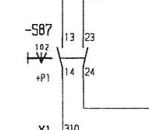Hi,
I would like your opinion on how to correctly draw a 2-position selector-switch (Hand-Automatic) under "IEC world". Should I draw both contacts opened and the switch neither in "H" nor "A"?
Both contacts themselves should be purchased "normal open" (NO) but one must be placed in such a way that it closes when the selector switch is in "H" and the other that should close when it is in "A"
Please see attached example
Thanks!
JBC
.......
"The more I read, the more I acquire, the more certain I am that I know nothing"
I would like your opinion on how to correctly draw a 2-position selector-switch (Hand-Automatic) under "IEC world". Should I draw both contacts opened and the switch neither in "H" nor "A"?
Both contacts themselves should be purchased "normal open" (NO) but one must be placed in such a way that it closes when the selector switch is in "H" and the other that should close when it is in "A"
Please see attached example
Thanks!
JBC
.......
"The more I read, the more I acquire, the more certain I am that I know nothing"


![[banghead] [banghead] [banghead]](/data/assets/smilies/banghead.gif)